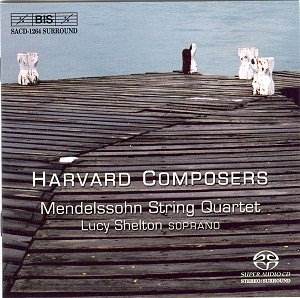All of these composers were professors of Music
at Harvard and the quartet, while now in residence at the North
Carolina School-of-the-Arts, were for nine years in residence
at Harvard University.
The String Quartet No. 1 is the most substantial
work I’ve heard from Walter Piston, my only musical acquaintance
with whom to date has been through his orchestral works. While
I rather liked the Munch recording of the 6th Symphony, I’ve never
cared for The Incredible Flutist. I heard Piston speak
at a seminar once in the late 1950s long after he had become an
establishment professor type, and he delivered a clever talk disparaging
electronic music, a safe topic since no one within miles would
dream of disagreeing with him. This work from the 1930s is much
more adventuresome that I’d expected — non-derivative, complex
and well crafted, neither pretty nor abrasive. "American
Style" makes only the merest shadow of an appearance. The
slow movement particularly is exceptional and unlike anything
else. The moto perpetuo finale is very entertaining. This
is the jewel of this recording and is very much worth hearing
if you like modern quartet music.
The Kirchner is a little less architectural,
more experimental and exploratory, and slightly less successful
a work than the Piston, although the last movement comes off very
well.
Kim’s soprano songs are not tuneful, but effectively
express the sad mood of the poems, two by Verlaine (En Sourdine,
Colloque sentimental), one by Baudelaire (Recueillement),
by means of long, lush, consonant lyrical phrases. The soprano
has a somewhat more live acoustic than the accompanying quartet,
leading one to wonder if the tracks were recorded on different
occasions. The booklet translations are accurate and pretty much
word-for-word literal, which is a good idea when one wants to
follow the words as sung.
The Bernard Rands work was written for the Mendelssohn
Quartet. It has a dark mood and contains self important dramatic
gestures but is not so successful overall.
The Davidovsky piece (also written for the Mendelssohn
Quartet) is inspired by, and utilises some motifs from, Beethoven’s
Quartet No.15, Op 132, and is subtitled "Dank an Opus 132,"
perhaps a nod back 100 years when every American composer of note
studied in Germany. Inviting a comparison with Beethoven is a
very brave thing to do and perhaps has the utility of directing
your attention away from Schoenberg’s Verklaerte Nacht,
etc., which seems to have been very much on the composer’s mind.
I have always felt that the Beethoven late quartets are the source
of dodecaphonic style, and this work seems to substantiate that
observation of mine, although what we have here is not strict
serialism. It is however very much in the style of modern quartet
music, measured and cut off the bolt. Since it isn’t pretty or
dramatic, it is difficult to keep one’s attention on it, and one
is not motivated to forgive it much however carefully it may have
been crafted.
While all this music on this disc is interesting,
I think that after you’ve had it a while you will probably not
play the Rands or Davidovsky works very often.
The beauty of the SACD tracks is that there is
"air" around every instrument, and since some of the
writing is warmly consonant, some intentionally dissonant, it
is important that the string texture be accurately reproduced,
as on the SACD tracks. In the soprano songs this is particularly
critical since the vocalist and instruments play in the same register,
and on the CD tracks tend to merge into a single sound, even though
soloist and accompaniment seem to be in different rooms acoustically.
But if you’d never heard the SACD tracks, you’d be very pleased
with the sound on the CD tracks, so it makes sense to buy this
disk and enjoy it in the meantime even if you don’t presently
have an SACD player.
On either set of tracks the surround sound is
strictly auditorium image with instruments in front and subtle
reverberation from the rear speakers, so subtle in fact that you
may prefer to listen to the two channel version with your ambient
processor turned on.
Paul Shoemaker
